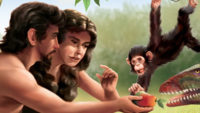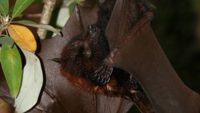How does the creation-based Coded Information Systems theory explain the nylon-eating bacteria? …read more Source: creation.com
Remarkably, when a number of reptilian mothers (including lizards, snakes, turtles, and alligators) bury eggs in warm, incubating sand, all the eggs may produce offspring of the same gender. Females develop at one temperature and humidity, males at another, and a ratio of both sexes at temperatures and humidity levels in between. Sophisticated research is finding some key molecular links between ambient temperature and reptile sex expressio… More… …read more Source: icr.org
The horseshoe crab is a marine arthropod and a testimony to the creative design and organization of God’s living creation. These odd crabs look much like crustaceans (lobsters, crabs and shrimp), but belong to a group of the subphylum Chelicerata. They have been created with a hard carapace (upper shell) and numerous eyes, including median eyes that can detect ultraviolet light, and a pair of lateral eyes each composed of a thousand ommatid… More… …read more Source: icr.org
By Dr. David Menton Of all of the claims of biological evolution perhaps none is more repugnant to conservative Christians than the bestial origin of man. …read more Source: AIG Daily
The incredible design of our respiratory system points to an intelligent Designer and not blind chance. …read more Source: creation.com
By Heather Brinson Bruce You don?t need to be an expert to appreciate the fine details that make this sleek machine run. …read more Source: AIG Daily
By Bodie Hodge People make the claim that it is impossible to get 7 billion descendants from two people. In kindness, where does the Bible say this is impossible? …read more Source: AIG Daily
A recent paper published in Proceedings of the Royal Society B may have inadvertently confirmed what the Bible revealed to us all along: Kinds only reproduce after their kinds.1 Kinds only reproduce after their kinds. <a target=_blank href="https://ctt.ac/oV8CG" target="_bla… More… …read more Source: icr.org
The argument “common design means common ancestry” falsely claims to prove an assumption about the past by pointing out similar body plans in organisms today. …read more Source: AIG Daily
By Tom Hennigan Creationists get so focused on finding evidence of design in individual organisms that they overlook the bigger picture—design of the ecosystems. …read more Source: AIG Daily
Did bacteria gain the ability to eat nylon through a random frame-shift mutation? …read more Source: creation.com
Like a thief in the night, this creature from the deep raids the fruits of the forest. …read more Source: creation.com
How were they discovered? Why are they important for the creation/evolution debate? …read more Source: creation.com
A common seaweed called rainbow wrack grows along Europe’s coasts, including tidal rock pools in the UK. Deep inside its cells, this marine plant uses oily chemicals to make opal look-alikes—“living opals.” This discovery intrigues nanotechnologists. Opals are gemstones renowned for the way they make white light shimmer with thin rainbow colors. Deep inside the opals, light bounces off very tiny ball… More… …read more Source: icr.org
“What was old is new again” describes fashion cycles where young people today are wearing clothes and buying furniture styled after that of their grandparents. Evolutionary biology also has similar cycles, especially when it comes to “new” ideas that are constantly revising the ill-defined concept of natural selection. W. Ford Doolittle and S. Andrew Inkpen recently advanced their new take on natural selection that a… More… …read more Source: icr.org
The honey bee is a wonderful example of intricate design and complex genetic information. …read more Source: creation.com
New plastic-munching Ideonella sakaiensis bacterium was intelligently engineered, not randomly evolved. …read more Source: creation.com
By Dr. Nathaniel T. Jeanson The ethical use of human stem cells controversy has cooled and almost subsided. But not for the reasons you might expect. …read more Source: AIG Daily
By Heather Brinson Bruce God designed your brain to fill in missing details on the fly . . . with some interesting consequences. …read more Source: AIG Daily
This ‘bone’ of contention is actually a reminder of God’s creative genius. …read more Source: creation.com
From its comical snout to its friction-reducing skin, this endangered fish bears testimony to its Designer. …read more Source: creation.com
By Dr. Nathaniel T. Jeanson Ironically, Frello has actually done me a great favor; his review ends up bolstering my original claims. …read more Source: AIG Daily
By Ken Ham The fossil record shows a great deal of diversity among post-Flood humans (scientists haven’t found any pre-Flood humans as of yet). Some of this diversity is seen in skull shape. Many ancient humans had much thicker brow ridges than we do today. Evolutionary scientists have tried to explain why humans lost these more robust faces. Their newest story—social communication. Other hypotheses for a physical reason for human brow structure didn’t stand up to the researchers’ computer modeling, so they finally landed on a social explanation for the change in faces. They concluded, early humans bore prominent brow [More]
Facing up to the complex issues surrounding an annoying bug. …read more Source: creation.com
By Melinda Christian Bats are amazing animals that display the unlimited creativity of our God. …read more Source: AIG Daily
Denisovans are ancient humans represented by various teeth and a finger bone found in a Siberian cave. Their claim to fame is largely based on the DNA extracted from these few fragments of human remains. According to evolutionists, they are more closely related to Neanderthals than modern humans. But their DNA is essentially human, and people all over the world today carry many of the same gene variants found in Denisovans. More… …read more Source: icr.org














































